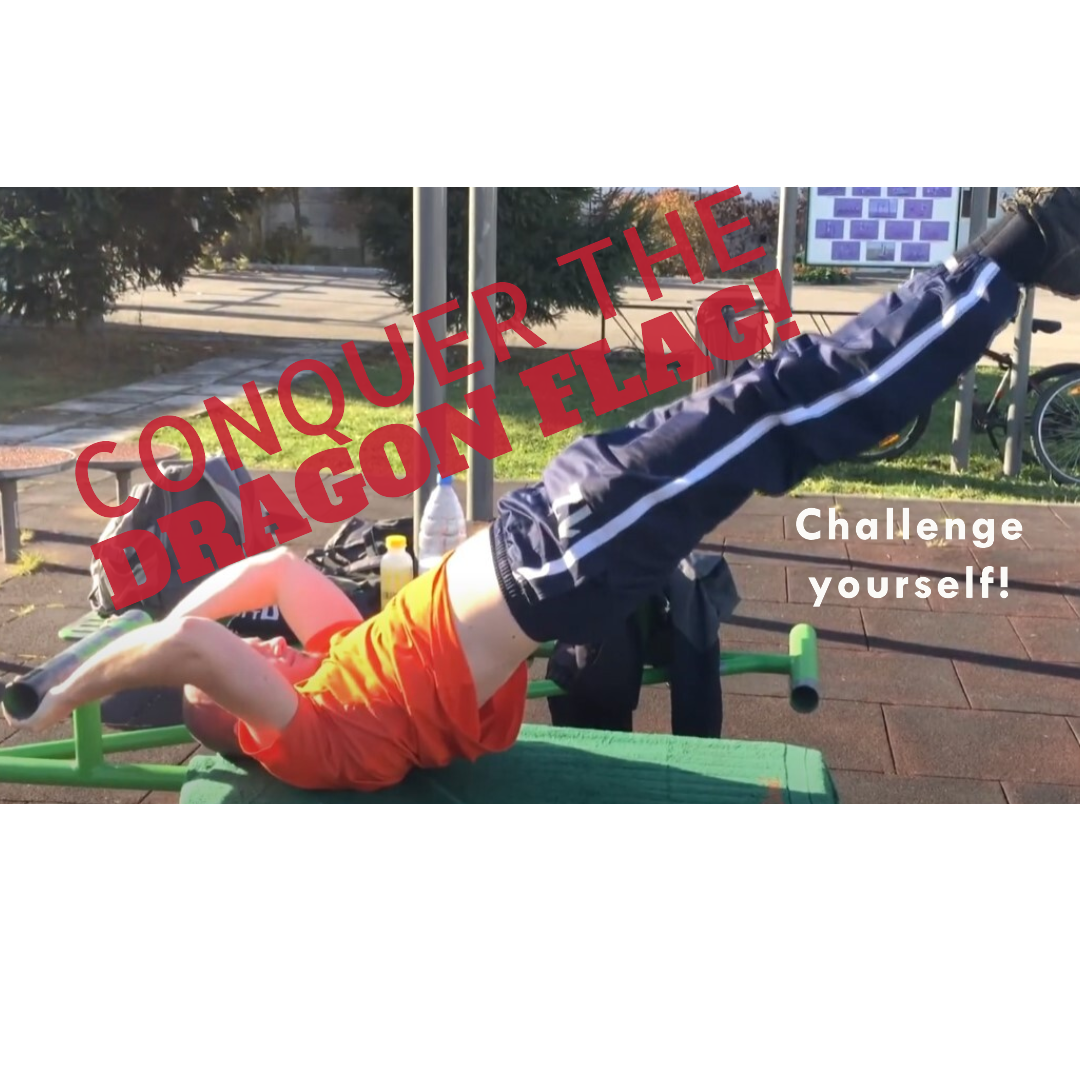Dragon Flags: Ultimate Guide to Boost Your Core Strength7 min read
If you’re looking to challenge your core and elevate your fitness routine, dragon flags are an exceptional exercise to consider. Dragon flags, an exercise popularized by martial arts master Bruce Lee and later adopted in many high-level training programs, are a great way to challenge your core.
In this comprehensive guide, we will explore the origins of dragon flags, delving into their connection with icons like Bruce Lee and Sylvester Stallone. You’ll learn how to perform full dragon flags correctly, ensuring proper form for maximum results. As you progress in your practice, we’ll provide tips on increasing difficulty and incorporating additional equipment for an even more intense workout.
Additionally, we will discuss common mistakes made while performing dragon flags and share safety precautions that should be taken during this demanding exercise. For those new to the world of dragon flags or needing modifications due to limitations or injuries, we have you covered with beginner-friendly variations.
By incorporating dragon flags into your fitness regimen, you can expect enhanced core stability and pulling strength as well as improved shoulder muscle mass development. Read on to unlock the secrets behind mastering this powerful move!
Table of Contents:
- The Origins of Dragon Flags
- Bruce Lee’s Influence on Dragon Flags
- Sylvester Stallone’s Use of Dragon Flags in His Training
- How to Perform a Dragon Flag Correctly
- Progressing Your Dragon Flag Workout
- Common Mistakes and Safety Precautions
- Beginner Modifications for Dragon Flags
- Benefits of Incorporating Dragon Flags into Your Fitness Routine
- FAQs in Relation to Dragon Flags
- Conclusion
The Origins of Dragon Flags
Dragon flags, a challenging bodyweight core exercise, gained popularity through martial arts master Bruce Lee and Hollywood actor Sylvester Stallone.
Bruce Lee’s Influence on Dragon Flags
Bruce Lee’s high level of athleticism led him to incorporate dragon flags into his training routine, helping him achieve exceptional core strength.
Sylvester Stallone’s Use of Dragon Flags in His Training
Sylvester Stallone incorporated dragon flags into his training regimen for movies like Rocky III (1983) to achieve a lean muscular physique.
- Core Stability: Dragon flags engage multiple muscle groups at once, improving overall core stability.
- Pulling Strength: Performing dragon flags helps develop pulling strength needed for exercises like pull-ups or chin-ups.
- Shoulder Muscle Mass Development: Maintaining proper form during dragon flags can lead to increased muscle mass in the deltoids and surrounding muscles over time.
Incorporating dragon flags into your workout routine can challenge you and improve your physical capabilities.
How to Perform a Dragon Flag Correctly
Mastering the dragon flag is no easy feat, but with proper technique and practice, you’ll be performing full dragon flags like martial arts master Bruce Lee in no time.
Starting Position
- Lie flat on a sturdy surface.
- Grip a stable pole or bench edge behind your head.
- Bend your knees slightly and keep your feet together.
Step-by-Step Guide
- Tighten your core muscles by drawing in your belly button towards your spine.
- Lift both legs simultaneously until they are perpendicular to the floor.
Maintain a rigid posture while executing the exercise, and be sure to keep breathing.
For more tips on the dragon flag workout and other advanced bodyweight exercises, check out Bodybuilding.com.
Progressing Your Dragon Flag Workout
If you’re a fan of the dragon flag, there are several ways to progress further and continue challenging your body.
Increasing Difficulty by Adding Weight or Resistance
- Ankle weights: Add ankle weights or heavy shoes to make it more challenging.
- Toes pointed: Point your toes to increase tension on your muscles.
Incorporating Additional Equipment into Your Routine
- Decline bench: Use a decline bench to increase the range of motion and work your core muscles harder. Check out this tutorial: “Dragon Flags on Decline Bench – Step-by-Step Guide”.
- Bruce Lee’s ball drop challenge: Hold a medicine ball between your knees or ankles as you execute full dragon flags for a high-level variation. For tips on mastering this advanced technique inspired by martial arts legend Bruce Lee himself, check out “Bruce Lee’s Ball Drop Challenge: A Comprehensive Guide”.
Remember, consistency and dedication are key when it comes to progressing your dragon flag workout. With regular practice, you’ll soon notice significant improvements in both your physical capabilities and muscular definition.
Common Mistakes and Safety Precautions
Form and focus are key to performing dragon flags without injury, so take care to avoid arching your back and warm up properly with dynamic stretches and light cardio.
Avoid Arching Your Back
Keep a straight line from head to toe to avoid straining your lower spine, and engage your core muscles throughout the movement.
Warm Up Properly
Dynamic stretches and light cardio increase blood flow and prepare your body for intense exercise.
- Mistake: Skipping warm-ups or not warming up enough before dragon flag workout.
- Solution: Allocate at least 10-15 minutes for an effective warm-up session that includes dynamic stretching and light cardio.
By following these safety precautions, you can perform dragon flags safely and reap the benefits of this challenging exercise.
For further information on dragon flags, including their advantages and how to do them correctly, have a look at Healthline’s guide.
And if you’re looking for inspiration, look no further than martial arts master Bruce Lee, who famously performed full dragon flags with ease.
Beginner Modifications for Dragon Flags
Start with modifications to build strength and proficiency in this challenging exercise.
Perform Negative Reps to Build Core Strength
Lower yourself down slowly while maintaining control of your movement.
Tuck Variations for Easing into Full Range of Motion
- Tuck Dragon Flag: Bend your legs at a 90-degree angle to reduce leverage and maintain proper form.
- Single Leg Tuck Dragon Flag: Extend one leg out straight while keeping the other knee bent in a tuck position to focus on building unilateral strength.
These modifications establish strong foundations in core stability and pulling strength necessary for mastering advanced bodyweight exercises like the human flag or martial arts master Bruce Lee’s famous dragon flag workout.
Benefits of Incorporating Dragon Flags into Your Fitness Routine
Get ready to perform dragon flags and take your fitness to the next level with these benefits.
Enhanced Core Stability and Pulling Strength
Dragon flags improve core stability and pulling strength by targeting multiple muscles including the rectus abdominis, lower back, obliques, glutes, biceps serratus anterior, and lats.
Improved Shoulder Muscle Mass Development
Dragon flags also contribute to shoulder muscle mass development by engaging multiple shoulder muscles including the deltoids and rotator cuff muscles.
- Martial arts master Bruce Lee popularized the move and showcased its effectiveness in achieving an incredible physique.
- This high level exercise promotes functional strength by requiring coordination between different parts of your body while maintaining proper form through its full range of motion.
- Performing dragon flags is an impressive display of strength and control that can serve as a source of motivation for yourself and others in your fitness journey.
Incorporating dragon flags into your routine can help you achieve a stronger, more defined physique while also improving functional strength necessary for various athletic endeavors.
FAQs in Relation to Dragon Flags
Are Dragon Flags Effective?
Yes, Dragon Flags are highly effective for building core strength and stability. They target various muscle groups, including the rectus abdominis, obliques, hip flexors, lower back muscles, and upper body muscles such as lats and triceps. This makes them a versatile exercise for overall functional fitness.
What Do Dragon Flags Do?
Dragon Flags primarily work on your core muscles by engaging them throughout the movement. The exercise also strengthens your upper body muscles like lats and triceps while improving balance and coordination. As an advanced calisthenics move, it challenges your entire body to develop better control and stability.
Why Is It Called a Dragon Flag?
The name “Dragon Flag” originates from martial arts legend Bruce Lee who popularized this challenging exercise in his training regimen. It’s said that the term “dragon” represents power and strength in Chinese culture – attributes that perfectly describe this intense workout technique.
How Long Should You Hold a Dragon Flag?
For beginners starting with modified versions of the exercise (like tucked or single-leg variations), aim to hold each rep for 2-4 seconds before lowering down slowly with control. As you progress towards full Dragon Flags, holding each repetition between 5-10 seconds will maximize their effectiveness while maintaining proper form.
Conclusion
In conclusion, dragon flags are a challenging and effective exercise that can help improve core stability and upper-body strength. Originating from martial arts, this exercise targets various muscles including the abs, back, and shoulders. Proper form is crucial to avoid injury, but beginners can start with modifications until they build up their strength.
By incorporating dragon flags into your workout routine strategically and increasing intensity with added resistance over time, you can see significant progress in your fitness journey. Mastering this exercise requires dedication and consistency but will ultimately lead to improved physical health.
If you’re looking for more guidance on incorporating dragon flags or other exercises into your workout routine, check out Fitness Mind for personalized training plans tailored to your goals.







